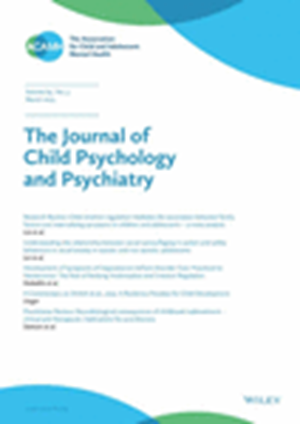父母收入与10至40岁的精神疾病:一项遗传信息性的人口研究
IF 7
1区 医学
Q1 PSYCHIATRY
引用次数: 0
摘要
背景:父母收入较低与后代出现更多精神疾病相关,但尚不清楚这种关联是否反映了父母收入(社会原因)或共同风险因素(社会选择)的影响。先前的研究发现了相互矛盾的结果,这可能是由于被研究后代之间的年龄差异。在此,我们研究了2006年至2018年期间挪威10至40岁人口的精神疾病(N = 2,468,503)。通过将税务登记与行政卫生登记联系起来,我们按年龄、性别和父母收入等级描述了患病率。接下来,我们将观察结果按年龄分组(青少年,10-20岁;成年早期,21-30岁;成年(30-40岁),并应用基于亲属关系的模型,对双胞胎和兄弟姐妹的大家庭进行分析,将亲子相关性分解为表型传递、被动遗传传递和被动环境传递。结果我们发现,父母收入等级越低,几乎所有精神疾病(饮食失调除外)的患病率越高,在10至40岁的所有年龄段的男性和女性中都是如此。比较父亲收入最高和最低的四分位数,任何精神疾病的患病率在10岁的孩子中为0.47,在40岁的孩子中下降到0.72。亲代相关性为−。青春期15岁,−。在成年早期10岁,−。06岁成年。基于亲属关系的模型表明,在青少年中,表型传递可能占亲子相关性的39% (p <;.001),但在成年早期(p = .181)或成年期(p = .737)无显著贡献。在所有年龄组中,被动遗传和环境传递都导致了亲子相关性(p's <;措施)。结论社会因素在青少年时期起着重要的作用,而社会选择可以充分解释成年期的亲子关系。本文章由计算机程序翻译,如有差异,请以英文原文为准。
Parental income and psychiatric disorders from age 10 to 40: a genetically informative population study
BackgroundLower parental income is associated with more psychiatric disorders among offspring, but it is unclear if this association reflects effects of parental income (social causation) or shared risk factors (social selection). Prior research finds contradictory results, which may be due to age differences between the studied offspring.MethodsHere, we studied psychiatric disorders in the entire Norwegian population aged 10 to 40 years between 2006 and 2018 (N = 2,468,503). By linking tax registries to administrative health registries, we described prevalence rates by age, sex, and parental income rank. Next, we grouped observations into age groups (adolescence, ages 10–20 years; early adulthood, 21–30 years; adulthood, 30–40 years) and applied kinship‐based models with extended families of twins and siblings to decompose the parent–offspring correlation into phenotypic transmission, passive genetic transmission, and passive environmental transmission.ResultsWe found that lower parental income rank was associated with higher prevalence of nearly all psychiatric disorders, except for eating disorders, for both men and women at all ages from 10 to 40 years. Comparing the top with the bottom paternal income quartile, the prevalence ratio of any psychiatric disorder was 0.47 among 10‐year‐olds and decreased to 0.72 among 40‐year‐olds. The parent–offspring correlation was −.15 in adolescence, −.10 in early adulthood, and −.06 in adulthood. The kinship‐based models indicated that phenotypic transmission could account for 39% of the parent–offspring correlation among adolescents (p < .001), but with no significant contribution in early adulthood (p = .181) or adulthood (p = .737). Passive genetic and environmental transmission contributed to the parent–offspring correlation in all age groups (all p 's < .001).ConclusionsOur findings are consistent with a significant role of social causation during adolescence, while social selection could fully explain the parent–offspring correlation in adulthood.
求助全文
通过发布文献求助,成功后即可免费获取论文全文。
去求助
来源期刊
CiteScore
13.80
自引率
5.30%
发文量
169
审稿时长
1 months
期刊介绍:
The Journal of Child Psychology and Psychiatry (JCPP) is a highly regarded international publication that focuses on the fields of child and adolescent psychology and psychiatry. It is recognized for publishing top-tier, clinically relevant research across various disciplines related to these areas. JCPP has a broad global readership and covers a diverse range of topics, including:
Epidemiology: Studies on the prevalence and distribution of mental health issues in children and adolescents.
Diagnosis: Research on the identification and classification of childhood disorders.
Treatments: Psychotherapeutic and psychopharmacological interventions for child and adolescent mental health.
Behavior and Cognition: Studies on the behavioral and cognitive aspects of childhood disorders.
Neuroscience and Neurobiology: Research on the neural and biological underpinnings of child mental health.
Genetics: Genetic factors contributing to the development of childhood disorders.
JCPP serves as a platform for integrating empirical research, clinical studies, and high-quality reviews from diverse perspectives, theoretical viewpoints, and disciplines. This interdisciplinary approach is a key feature of the journal, as it fosters a comprehensive understanding of child and adolescent mental health.
The Journal of Child Psychology and Psychiatry is published 12 times a year and is affiliated with the Association for Child and Adolescent Mental Health (ACAMH), which supports the journal's mission to advance knowledge and practice in the field of child and adolescent mental health.

 求助内容:
求助内容: 应助结果提醒方式:
应助结果提醒方式:


